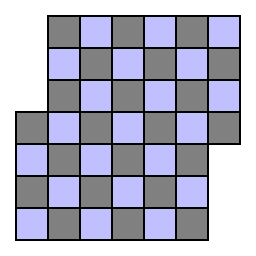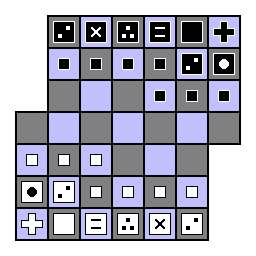Rook Mania
By Jared B. McComb

|
IntroductionRook Mania is a game played on the board shown at left. The board has 43 squares. The two players are Black and White, and the pieces are all variations of Rooks. Each player starts with 15 pieces covering 8 different Rook variations. In the spirit of true and genuine Rookery, there are no real diagonal moves in this game whatsoever. |
SetupThis is the opening setup. Each player has seven pawns, one Rook, one Pao, one Slip Rook, one Basilisk, two Twosteps, one Threestep, and one King. In the diagram, the pawns are represented by the little boxes, the King by a cross, and the other pieces by squares with symbols; the Rook is left blank, the Pao has a circle, the Slip Rook has two lines, the Basilisk has an X, the Twostep has two dots, and the Threestep has three. |

|
Rules
Except for the different pieces and the funny board, all rules are identical to FIDE Chess.
Piece Moves
![]() The Pawns behave almost like the
Pincer Pawns
from Ultima; that is,
they move like Chess Rooks and capture by orthogonal custodianship.
However, unlike Ultima Pincer Pawns, they may only capture
in cooperation with other Pawns, not with other friendly pieces.
When a player is reduced to one pawn, that pawn still retains
its Rook move, but gains the capturing powers of the
Coordinator
from Ultima; this is to keep singular pawns from becoming
completely useless. Pawns do not promote and have no special
first moves.
The Pawns behave almost like the
Pincer Pawns
from Ultima; that is,
they move like Chess Rooks and capture by orthogonal custodianship.
However, unlike Ultima Pincer Pawns, they may only capture
in cooperation with other Pawns, not with other friendly pieces.
When a player is reduced to one pawn, that pawn still retains
its Rook move, but gains the capturing powers of the
Coordinator
from Ultima; this is to keep singular pawns from becoming
completely useless. Pawns do not promote and have no special
first moves.
![]() The Rook is from FIDE Chess, and retains its traditional movement
and capture methods.
The Rook is from FIDE Chess, and retains its traditional movement
and capture methods.
![]() The Pao is from Xiang-Qi.
It may move like a Rook, but when capturing, there must be a single piece
between the Pao and the captured piece. This piece is called the screen,
and when the Pao captures, it jumps over the screen.
The Pao is from Xiang-Qi.
It may move like a Rook, but when capturing, there must be a single piece
between the Pao and the captured piece. This piece is called the screen,
and when the Pao captures, it jumps over the screen.
![]() The Slip Rook moves as a
Wazir, and then may continue to move
in the same direction as a Dababbah-rider if the player so chooses.
It captures in this same manner. This piece is described in some detail on
this page.
The Slip Rook moves as a
Wazir, and then may continue to move
in the same direction as a Dababbah-rider if the player so chooses.
It captures in this same manner. This piece is described in some detail on
this page.
![]() The Basilisk moves as a Rook, and does not capture. Rather, it
immobilizes the first enemy piece it can ?see? along its lines of
movement. Immobile pieces cannot move, but they can still be used
as screens by a Pao. The effect goes away as soon as the Basilisk
can no longer ?see? the victim. Basilisks are immune to each other.
A piece may move through a square that a Basilisk sees without stopping.
The Basilisk moves as a Rook, and does not capture. Rather, it
immobilizes the first enemy piece it can ?see? along its lines of
movement. Immobile pieces cannot move, but they can still be used
as screens by a Pao. The effect goes away as soon as the Basilisk
can no longer ?see? the victim. Basilisks are immune to each other.
A piece may move through a square that a Basilisk sees without stopping.
![]() The Twostep is somewhat borrowed from
Jetan. It moves exactly two
spaces like a Rook, but it may change directions in its move. It may
not move to the same space twice during its move, and it may only capture
on the last step of its move. Twosteps are colorbound.
The Twostep is somewhat borrowed from
Jetan. It moves exactly two
spaces like a Rook, but it may change directions in its move. It may
not move to the same space twice during its move, and it may only capture
on the last step of its move. Twosteps are colorbound.
![]() The Threestep is also borrowed from
Jetan. It moves exactly three
spaces like a Rook, but it may change directions in its move. It
may not move to the same space twice during its move, and it may
only capture on the last step of its move.
The Threestep is also borrowed from
Jetan. It moves exactly three
spaces like a Rook, but it may change directions in its move. It
may not move to the same space twice during its move, and it may
only capture on the last step of its move.
![]() The King is the same as its FIDE counterpart, except that
it may neither move nor capture diagonally. However, the King
carries a pistol for self defense, and twice during the game, he
may shoot a piece that directly attacks him along an orthogonal
line at any distance. If he is immobilized, however, he may still
shoot, but Basilisks are immune to bullets due to their thick, scaly
skins. Kings may not shoot Kings, as they are protected by
bullet-proof vests. Checkmate of the opposing King
wins the game.
The King is the same as its FIDE counterpart, except that
it may neither move nor capture diagonally. However, the King
carries a pistol for self defense, and twice during the game, he
may shoot a piece that directly attacks him along an orthogonal
line at any distance. If he is immobilized, however, he may still
shoot, but Basilisks are immune to bullets due to their thick, scaly
skins. Kings may not shoot Kings, as they are protected by
bullet-proof vests. Checkmate of the opposing King
wins the game.
Tips
The Threestep is one of the most powerful pieces in the game - protect it! They are near impossible to block and can be used to attack a piece that is not in the same rank or file as they are. The Twosteps are not nearly as powerful, having a shorter range and being colorbound, but they can be valuable when used as a pair.
The Basilisk can be extremely valuable when trying to pin down your opponent's King, or when trying to get at their Threestep. It is possible to use another of your pieces to eliminate the threat of a Basilisk by moving in between the two of them.
Learn to use the Pao! Since they can only capture pieces that are behind other pieces, you can use them to attack the opposing Basilisk with impunity. This also applies somewhat to the Slip Rooks.
The Rooks are somewhat powerful, as they can deliver a consistent attack to a row or column, but they do not work well by themselves. You need to use them in conjunction with other pieces to make them really worth something other than a bullet absorber.
Remember that Kings may not move diagonally, so their options of escape are limited! In many cases, their only available routes are perpendicular to the attack. It is possible to mate with as few as two pieces, and sometimes with one if the King?s area is constricted. And you need to be prepared to sacrifice a piece to the King?s pistol, too, if you are going to attempt checkmate without a Basilisk.
Computer Play
There is currently no way to play this game on your computer whatsoever.
Credits
This game was inspired by Xiang-Qi, Jetan, and Ultima, as well as something else that I?m probably forgetting. I had been wanting to do an entirely orthogonal game for a while now, and so I used the 43S Contest as an excuse to do so.
Written by Jared B. McComb. HTML Conversion by Peter Aronson.
WWW page created: April 6th, 2003.